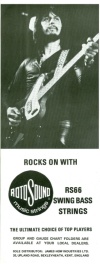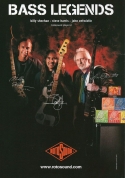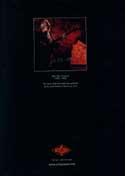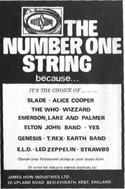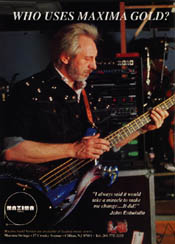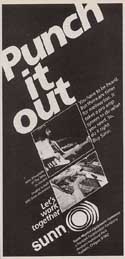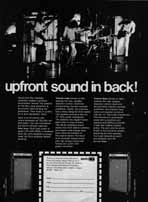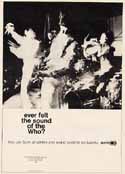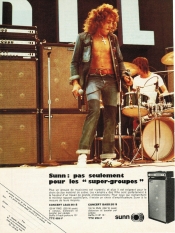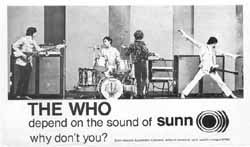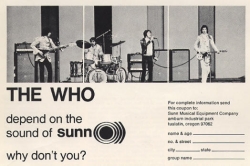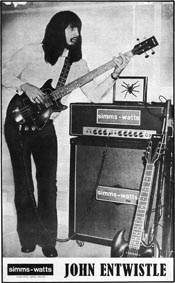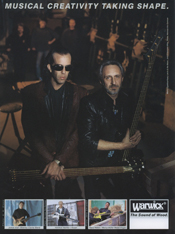John Entwistle’s Gear: Endorsements and Signature Series
A work-in-progress catalogue of John Entwistle’s product endorsements and signature series, similar to the Pete Townshend’s Endorsements and Signature Series section. This section is undoubtedly incomplete. If you have additions, please contact us.
Table of contents
Strings
Rotosound Strings
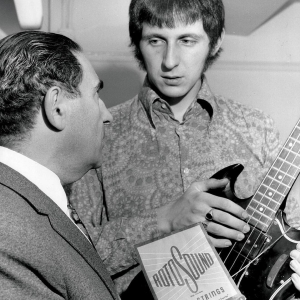
John with sales director Alan Marcuson of Rotosound Strings, and holding a Gibson EB-3 bass.
John helped design and endorsed Rotosound RS 66 Swing Bass roundwound strings (.045 – .105) from 1966 to the mid ’80s.
From April 1995 Bassist interview
Rotosound Strings: rotosound.com
- How did the link [with Rotosound] evolve?
“It was in 1966 and I was looking for that Danelectro sound again. I tried everybody’s strings but the E and the A’s just didn’t work. It was the same with Rotosound but there was something about them that was almost there but not quite. To solve the problem I got in touch with James Howe[sic] and told him his D and G strings were great but the E and A didn’t vibrate properly. He told me to take my bass along to Rotosound and have some strings made until they got it right. After a couple of hours, we realised that the problem wasn’t in the wire winding, but in the core of the string. You could see that the strings vibrated in a big circle and that was wrong; the core needed to be thicker. We also made the overall gauges a bit heavier and they sent me away with 12 sets to use. A couple of days later they called and asked if I objected to them putting my name to the strings and selling them commercially. I told them I didn’t mind as long as they kept me supplied with free strings! But then we had to do the same with medium and short scale strings because I had loads of different basses by then. Those strings, the RS 66 sets, were the first that vibrated properly other than the Danelectros.”
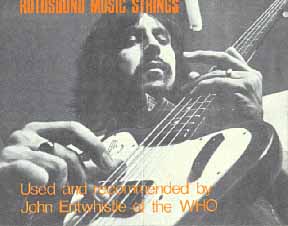
Rotosound ad, courtesy thewho.org.
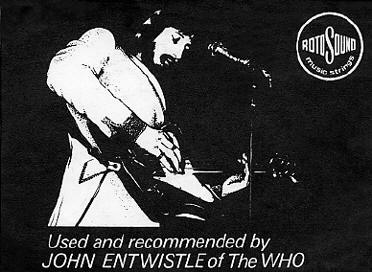
Rotosound ad, ca. 1975, courtesy WhiteFang’s Who Site.
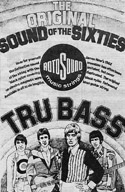
Click to view larger version. Rotosound ad, ca. 1978, courtesy WhiteFang’s Who Site.
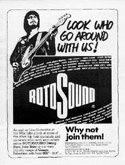
Click to view larger version. Rotosound ad, ca. 1980, courtesy WhiteFang’s Who Site.
Maxima Gold Strings
From 1989 to 2001, John used and endorsed Maxima Gold gold-plated handmade strings.
maxima-lines.com/stringsmain.htmAmplifiers
Sunn
John began using Sunn amplifiers in 1967, and came back to them in 1971. The Who and John endorsed Sunn amplifiers beginning in 1967.
Sunn Amplification: sunnamps.com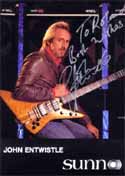
Click image to view larger version. Sunn ad, courtesy thewho.org.
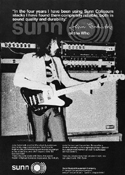
Click to view larger version. Sunn ad, ca. 1974. Courtesy WhiteFang’s Who Site.
Simms-Watts (1972)
Around 1972, John provided endorsement to his luthier/guitar maker Peter Cook’s Ned Callan guitars, which were distributed by Simms-Watts. Peter Cook would go on to assemble John’s Fenderbirds. John appeared in promotions for Simms-Watts amplifiers and Ned Callan basses.
For more information:
Dr. Tube Schematics: drtube.com/guitamp.htm#Simms
Trace Elliot
In the late 1980s or early 1990s, John provided endoresement to Trace Elliot amplifiers, which he had begun using around 1988. Trace Elliot’s chief engineer and part owner, Mark Gooday, would go on to found Ashdown Engineering in 1997, following Kaman’s acquisition of Trace Elliot in 1992.
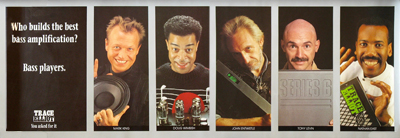
Ashdown Engineering
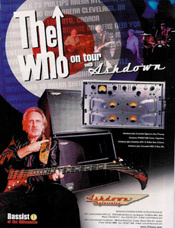
Click to view larger version. Ashdown ad from June 2001 Bass Player magazine. Courtesy whocollection.com.
John continued his relationship with Mark Gooday following his 1997 departure from Trace Elliot following the company’s 1992 sale to Kaman. Gooday then founded Ashdown Engineering in 1997, and began making amplifiers and the same A.S.S. speakers for John.
In 2001, Ashdown Engineering introduced the following products:
- Ashdown John Entwistle Signature bass preamp (archived)
- Ashdown John Entwistle ASS 112 1×12″ reflex bass cabinet
- Ashdown John Entwistle ASS 212 2×12″ reflex bass cabinet (archived)
- Ashdown John Entwistle ASS 115 1×15″ bass bin (archived)
Ashdown also produced a 100-watt practice amp named after John, the Five Fifteen (archived).
From Ashdown press release:
Ashdown Unveils John Entwistle Bass Preamp
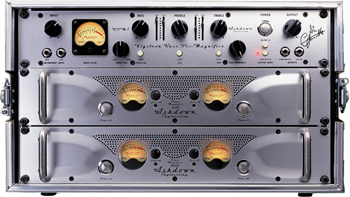
Ashdown RPM1, PM600 and PM900
January 18, 2001
U.K. bassamp specialist Ashdown Engineering is unveiling a limited-edition John Entwistle bass preamplifier at NAMM 2001. With only 100 units available, the custom preamp is a special, alloy-fronted version of Ashdown’s groundbreaking RPM1, used by the legendary Who bassist on the band’s hugely successful recent world tour, and features the “Bass Player of the Millennium’s” signature.
Entwistle’s current touring rig is all Ashdown, comprising three RPM1 preamps and three PM1000 power amps, feeding 3,000 watts into 2 pairs of Ashdown ASS115 and ASS212 cabinets. “In four decades of bass playing, I’ve never heard anything quite like it,” he says. Catch one of the remaining Who shows if you don’t believe him!
“John is a true legend and the man responsible for bringing bass playing into the foreground,” comments Ashdown’s Mark Gooday. “We’re naturally proud to be powering a musician for whom great sound remains of the utmost importance.”
In 2015, Ashdown Engineering re-released some of the JE signature products. 23 Jan. 2015 press release:
Ashdown EngineeringJohn Entwistle RPM-1 and APM-1000 rig
Ashdown are re-issuing the late John Entwistle’s rig of choice, used on his last tour. Comprising of the RPM-1 pre amp and APM-1000 power amp, the rig has the same specs used on the originals he loved so much.
The RPM-1 rackmounting preamp is based on the ABM EVO II and features a powerful 7-band EQ, blendable solid state preamp and Sub Harmonic Generator as well as a balanced DI out and a line for connecting any external audio source.
The ABM-1000 is a 2 x 500w power amplifier, deisgned to ensure robust performance. It features quad-fan cooling technology and each channel has its own toroidal transformer.
Bass Guitars
Alembic Spyder bass (2002)
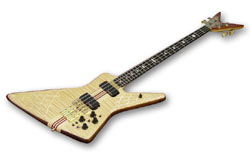
Alembic Spyder bass. ©Alembic
In 2002, Alembic designed this bass after John’s custom Alembic Explorer (Exploiter) bass guitars, though not exact replicas.
These were limited-edition items, with 50 four-string models and 25 eight-string models produced.
For more information, see Alembic: The Spyder Bass.
BaCH (2010)
BaCH FT-1 ‘Fenderbird’

BaCH Fenderbird. Photo: BaCH
BaCH Music Equipment, a Czech company, produced a bass in conjunction with numberoneguitars.com modeled after John’s “Fenderbird” bass guitars.
There are four models:
- FT-1 OR – Red/orange finish
- FT-1 DHB – Sunburst
- FT-1 OR LH – left-handed
- FT-1 OR Small Plato – limited edition
Per numberoneguitars:
A tribute to the late great John Entwistle bass; the Fenderbird. Awesome hybrid between a Thunderbird and a Fender P bass. This bass has a mahogany body and bolt on maple neck. Two humbuckers and a handmade bridge plus tailpiece.
In general, the instrument features:
- Mahogany Sipo body
- 34″ maple bolt-on neck with maple fingerboard
- BaCH hardware
- Bass humbucker pickups with chromed plastic covers
For more information, see:
- bachmusik.com/en/music-instruments/bass-guitars/model-bach-ft
- numberoneguitars.com/shop/index.php/basses/computers/fenderbird.html
Dean John Entwistle signature bass series
2012
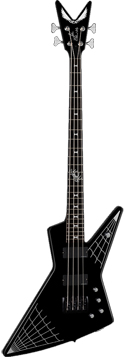
Dean John Entwistle Signature.
Dean Guitars announced at the January 2012 NAMM show that they will offer a production model of the John Entwistle signature bass guitar it introduced in 2011. The John Entwistle Spider model will feature:
- Alder top and body
- 34″ scale
- Set Mahogany “C” neck with ebony fingerboard
- Pearl “Black Widow” Inlays
- Pearl “Spider” custom 12th inlay
- Grover tuners
- Chrome hardware with black bridge
- Dual-purpose die-cast bridge
- EMG HZ Humbucker pickups
- Finishes: Classic Black with Silver Webs
2011
Dean Guitars announced in January 2011 that they will offer John Entwistle signature bass guitars in cooperation with the John Entwistle estate. The “Spider” is a limited edition (25 only) based on John’s custom Alembic Explorer (Exploiter) bass guitars, and two Hybrid models based on the Gibson Thunderbird IV bass (“Non-Reverse”-style) and “Fenderbird” bass guitars.
Dean press release, 11 January 2011:
NAMM 2011: Dean launches John Entwistle signature bass series
Dean Guitars and the John Entwistle estate will be unveiling two models of the new John Entwistle bass line at the 2011 Winter Namm show in Anaheim, California, 13–16 January.
According to John’s son Chris Entwistle, the estate chose Dean because of their attention to detail plus their willingness and ability to bring the project to market swiftly without sacrificing quality.
Steve Luongo, John’s drummer and personal friend of 15 years, steered the estate to Dean Guitars as he knew company CEO Elliott ‘Dean’ Rubinson is a touring bass player who grew up on John’s playing. “Brand was not as important to John as the actual playability and John would let the instrument do the talking,” said Luongo. “John has been a huge influence on me and I am proud to be on the front line in the development of these instruments, also being able to play and hear them live on stage when playing with the Michael Schenker Group and Cactus,” Rubinson said.
The first two models in the new Entwistle line are ‘The Spider’ and ‘The Hybrid,’ both made in Dean’s legendary USA Custom Woodshop in Tampa, FL. Both of these USA models will incorporate the new Aphex Exciter/Big Bottom/Compression circuit on board, an industry first. There is also a Hybrid model that sells for under $1,000.
“I know that if John were here today he would love these basses,” said company CEO Rubinson, who will join Steve Luongo and Mark Hitt on stage at the Dean Guitars 2nd Annual NAMM JAM party, Fri. 14 Jan. at The Grove of Anaheim, where the bass will be played in public for the first time.
USA John Entwistle Spider
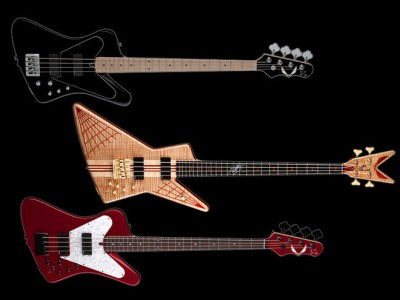
Top: USA JE Hybrid; middle: USA JE Spider; bottom: Hybrid.
- Flame Maple top and back with Mahogany body
- Padauk Spider Web, logo and cavity covers
- 34″ scale
- Maple neck thru with Padauk stringers
- Ebony fingerboard/brass nut
- Padauk “Black Widow” Inlays
- Pearl “Spider” custom 12th fret inlay
- Grover tuners with Hipshot
- Gold hardware, Babicz bridge
- EMG Lo-Z pickups w/active 3-band EQ
- Aphex Exciter®/Compressor/Big Bottom® circuit
- Gloss natural finish
- Limited run; only 25 produced worldwide
USA John Entwistle Hybrid
- Mahogany top/body
- 34″ scale
- Bolt-on maple neck with Dean custom 4-bolt neck cavity
- Rosewood or Maple fingerboard
- Abalone dot inlays
- Die-cast tuners with Hipshot
- Black hardware
- Dual-purpose die-cast bridge
- EMG Lo-Z pickups
- Active 3-band EQ
- Aphex Exciter®/Compressor/Big Bottom® circuit
- Metallic Red, Classic Black and Trans Brazilia finishes available
John Entwistle Hybrid
- Alder top/body
- 34″ scale
- Bolt-on maple “C” neck
- Maple fingerboard
- Black dot inlays
- Die-cast tuners
- Chrome hardware
- Dual-purpose die-cast bridge
- EMG HZ humbucker pickups
- Classic Black and Trans Brazilia finishes available
Lakland John Entwistle Signature ‘Fenderbird’
Prototype only of John’s infamous “Fenderbird” — Gibson Thunderbird bodies fitted with Fender Precision Bass necks.
From John MacDonald:
lakland.com andThis bass was to be a tribute to John’s custom Fenderbirds, but when John died the project was canceled. This is the prototype, briefly owned by Steve Barr (vintagebass.com [offline] and p096.ezboard.com/bthedudepit [offline]), and now owned by private collector.
Measurements for this prototype were taken from a Gibson Thunderbird I would borrow from my friend’s store whenever my Alembic was being repaired. The bass was sent to Lakland for this project.
vintagebass.com (offline) and
p096.ezboard.com/bthedudepit (offline)
Prototype Lakland Fenderbird photos

Click to view larger version. Lakland prototype, courtesy Steve Barr and John MacDonald.

Click to view larger version. Lakland prototype, courtesy Steve Barr and John MacDonald.

Click to view larger version. Lakland prototype, courtesy Steve Barr and John MacDonald.

Click to view larger version. Lakland prototype, courtesy Steve Barr and John MacDonald.
Ned Callan (1972)
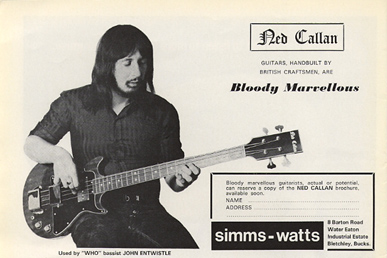
1972 Ned Callan endorsement, with John playing a Ned Callan bass.
Around 1972, John provided endorsement to his luthier/guitar maker Peter Cook’s Ned Callan guitars, which were distributed by Simms-Watts. Peter Cook would go on to assemble John’s Fenderbirds. John appeared in promotions for Simms-Watts amplifiers and Ned Callan basses.
Status Graphite John Entwistle Buzzard Bass (1998)
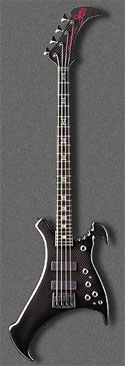
Status Graphite John Entwistle Buzzard Series 1 bass.
Status Graphite, the third company John worked with on the Buzzard concept (the concept he used on stage from 1989 to 2002 from different manufacturers), offered the Status Graphite John Entwistle Buzzard and Buzzard 2 models.
Status Graphite catalogue description from 1998:
John Entwistle Buzzard
As one of the most influential bass players ever, John Entwistle has shaped many bassists’ styles over the last 30 years; always an outrageous player, John designed The Buzzard to be equally outlandish.
The Buzzard is the first bass to be constructed from a one-piece graphite moulding — ensuring outstanding stability and en even response all over the 26 fret neck. The phenolic fingerboard has Roman numeral inlays and side-mounted LED position markers.
The striking body shape is designed to balance well on a strap or in a sitting position and is host to a custom made active circuit which allows a vast amount of control over the tone of the bass. The unique construction of this instrument and the sophisticated circuitry contained within it ensures that The Buzzard sounds as powerful as it looks.
Status Graphite John Entwistle Buzzard Bass (1998)
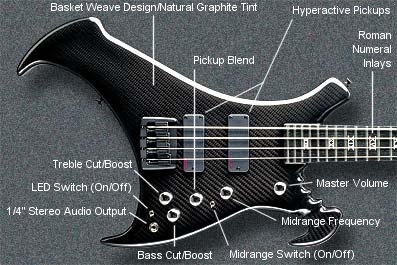
Status Graphite John Entwistle Buzzard bass detail.
The Buzzard 1, based on John’s stage bass guitar model from 1996 to 2002, features:
- Four-string woven graphite one-piece instrument
- Natural graphite with gloss lacquer
- 34″ (864mm scale), 26 frets with zero fret
- Phenolic fingerboard with Roman numerals
- Red side LEDs
- Chrome hardware
- Two Status soap-bar pickups
- Custom three-band EQ with midrange sweep control
- 18-volt power supply
- $5,995
Status Graphite Buzzard-2 (1999)

Status Graphite John Entwistle Buzzard 2 bass.
John Entwistle Buzzard 2 Bass, a design that had been custom-made for John, featured many of the original Buzzard features but in a traditional body shape made out of alder. On 3 March 1999, Status Graphite announced that the Buzzard 2 would premiere at the upcoming MusikMesse ’99 in Frankfurt, Germany.
- Graphite bolt-on neck with 26 frets and Roman numeral fingerboard inlays.
- Alder body with gloss black lacquer, designed by John Entwistle.
- Two Status Hyperactive pickups.
- 18-volt custom-designed circuit with active treble/bass cut/boost plus variable frequency midrange switchable for boost/flat as fitted on the original Buzzard.
- 34″ scale, 26-fret neck with Roman numeral fingerboard inlays.
- Chrome hardware
- $2,795
buzzardbass.com (offline)
Wal basses (1979)
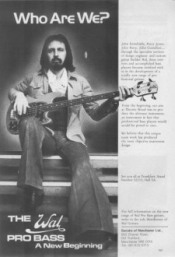
Around 1979, John put his name to Wal basses, of which he owned a 1978 fretless Wal bass, which was sold in the May 2003 Sotheby’s auction.
walbasses.co.uk andWal History
Warwick (2003)
Beginning in 2003, Warwick introduced four different production models of the Buzzard concept, with — according to Warwick — the “full support of the John Entwistle estate.” In 2005, they released another John-attributed concept: the Cruiser (later the Stryker).
Warwick press release: 5 May 2003
The Buzzard has landed again…
Even though the sad and unexpected passing of “The Who” bassist John Entwistle now dates back almost two years, the interest in his life’s work still continues. A current Custom Shop model that Warwick made for a collector is just the proof — it’s the legendary Buzzard design John developed in close collaboration with his great friend Hans Peter Wilfer (founder & general manager of Warwick) which became his trademark instrument over the years.
The instrument is based on a Buzzard Ltd. bass: Zebrano body, Ovangkol Thru neck and MEC P/P-pickups with special matched 2-way electronics that speak that magic language John showed with hundreds of his great songs.
The Airbrush-finish is a detailed replica made from the original art design of one of the first Buzzards Warwick built for Mr. Entwistle. Finally an additional fretboard inlay honours the grand master and reminds us of the extraordinary musician and wonderful man, that we all still bitterly miss and will do for many years to come.
Price: Custom Shop Airbrush Buzzard approx. £ 3.728
- Warwick Buzzard LTD 2003
- Warwick Buzzard 8 String (2004?)
- Warwick Buzzard bolt-on (4-string and 5-string versions)
- Warwick Cruiser Bass (2005)
- Warwick Stryker Bass (2006)
Warwick Buzzard LTD 2003
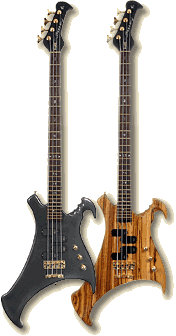
Warwick Buzzard LTD 2003
A limited-edition issue of John’s Buzzard concept, which was originally designed by John and Warwick’s Hans Peter Wilfer.
- Neck-through-body design
- Zebrano body
- Ovangkol neck with wenge fingerboard; numeric fret markers (actual numbers) custom inlaid of paua abalone.
- Buzzard “beak” headstock with four-in-line tuners.
- Two P-style active MEC pickups
- Two-band active MEC electronics
- In natural oil finish, red, black or white metallic Flip Flop high-polish finish with gold hardware.
(offline) buzzardbass.com/Warwick/Warwick.htm (offline)
Buzzard Bolt-On
A bolt-on-neck version of John’s Buzzard concept, similar in design to the regular Buzzard but with some more basic design features.
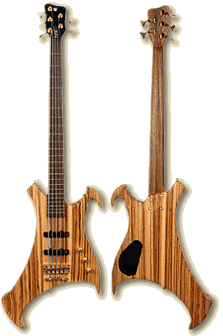
Warwick Buzzard Bolt-on
- Bolt-on neck design
- Zebrano body
- Ovangkol neck with wenge fingerboard and jumbo bell brass alloy frets; numeric fret markers (actual numbers) custom inlaid of paua abalone.
- Standard (non-Buzzard) headstock.
- Four-string version:
- Two P-style active MEC pickups
- Five-string version:
- Two J-style active MEC pickups
- Two-band active MEC electronics
- In natural oil finish with gold hardware
buzzardbass.com/Site/Warwick/Warwick.htm (offline)
Warwick Cruiser bass (2005)
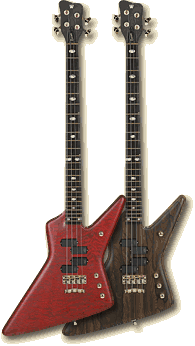
Warwick Cruiser
In 2005, Warwick introduced the “Cruiser” bass, with, according to Warwick, the full support of the John Entwistle Estate.
With the full support of the John Entwistle estate, Warwick is proud to introduce the Cruiser bass, which is a design that John made popular both with the Who and on his solo projects. The Cruiser bass features a hollow mahogany body with either a quilted maple or ziricote top. This neck-thru bass comes with a laminated maple neck, ebony fingerboard and custom “Spirit” inlays. This bass is truly a beautiful piece of art.
Art that rocks, that is! The Cruiser comes loaded with active MEC Gold P-style pick-ups, installed in the familiar “mirror image” manner that John favored. Inside the control cavity you will find an active MEC 3-band preamp that perfectly supports the blend of spectacular tone woods that this bass features. The Cruiser is the total package when it comes to a bass that plays as great as it looks.
The Cruiser is only available in a 4-string version and should be hitting music stores later this year. If you are going to hit the Strip, you need to have a Cruiser!
Based on John’s Alembic Explorer, this bass features:
- Hollow mahogany body with quilted maple or ziricote top.
- Laminated maple neck with custom “Spirit” inlays; neck-through-body design.
- Two MEC Gold P-style pickups in “mirror-image” configuration.
- Onboard MEC three-band preamp.
- Available later 2005.
For more information, see warwickbass.com/basses/cruiser.html (offline)
Warwick Stryker bass (2006)
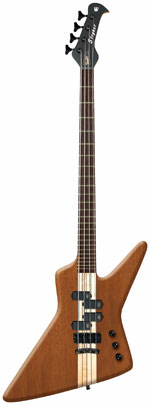
Warwick Stryker in Mahogany
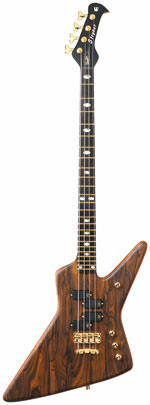
Warwick Stryker in Ziricote
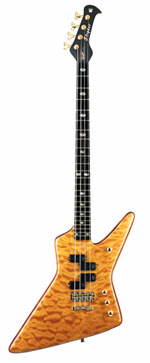
Warwick Stryker in natural maple
In 2006, Warwick apparently renamed the Cruiser line as the “Stryker.” The line was designed with, according to Warwick, the full support of the John Entwistle Estate.
With the full support of the John Entwistle estate, Warwick is proud to introduce the Stryker, which is a design that John made popular both with the Who and on his solo projects. The Stryker features a hollow mahogany body with either a quilted maple or ziricote top. This neck-thru bass comes with a laminated maple neck, ebony fingerboard and custom “Spirit” inlays. This bass is truly a beautiful piece of art.
Art that rocks, that is! The Stryker comes loaded with active MEC Gold P-style pick-ups, installed in the familiar “mirror image” manner that John favored. Inside the control cavity you will find an active MEC 3-band preamp that perfectly supports the blend of spectacular tone woods that this bass features. The Stryker is the total package when it comes to a bass that plays as great as it looks.
The Stryker is only available in a 4-string version and should be hitting music stores later this year. If you want to punch out killer bass lines, you need to have a Stryker!
Based on John’s Alembic Explorer, this bass features:
- Neck-through design
- 4-string only
- 34″ Scale Length
- 24 Bell Brass Frets
- Active MEC P/P Style Pickups (mirrored placement)
- Active MEC 2-Band Preamp
- Warwick Tuners
- Warwick 2-piece Bridge
- Warwick Strap Locks
- Justanut III
- Comes strung with Warwick EMP Strings (.45 to .105)
Stryker Mahogany Bass:
- Mahogany Body
- Maple neck with Wenge Fingerboard
- Weight: 10.8 lbs
Stryker TCS Ziricote Bass:
- Ziricote top and back with mahogany core
- TCS Tone Chambers in body
- Flamed Maple Neck with Tigerstripe Ebony Fingerboard
- Weight: 11.24 lbs
Stryker TCS Quilted Maple:
- Quilted Maple top and back with a mahogany core
- TCS Tone Chambers in body
- Flamed Maple Neck with Tigerstripe Ebony Fingerboard
- Weight: 10.14 lbs
For more information, see warwickbass.com/basses/cruiser.html (offline)
